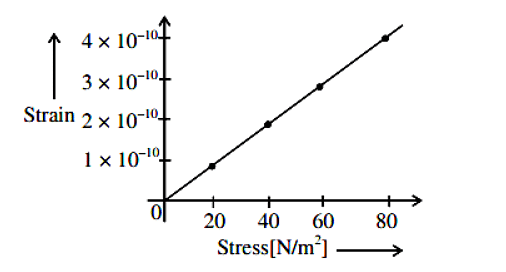A 14.5 kg mass, fastened to the end of a steel wire of unstretched length 1.0 m, is whirled in a vertical circle with an angular velocity of 2 rev/s at the bottom of the circle. The cross-sectional area of the wire is 0.065 cm2 . Calculate the elongation of the wire when the mass is at the lowest point of its path.
Solution and Explanation
Mass, m = 14.5 kg
Length of the steel wire, l = 1.0 m
Angular velocity, ω = 2 rev / s
Cross-sectional area of the wire, a = 0.065 cm2
Let δl be the elongation of the wire when the mass is at the lowest point of its path. When the mass is placed at the position of the vertical circle, the total force on the mass is: F = mg + mlω2
= 14.5 × 9.8 + 14.5 × 1 × (2)2
= 200.1 N
\(Young's modulus = \frac{Stress }{ Strain}\)
\(Y =\frac{ \frac{F }{ A} }{ \frac{Δl }{ l} }= \frac{F \,l }{A Δl}\)
\(∴ Δl =\frac{ Fl }{ AY}\)
Young’s modulus for steel = 2 × 10 11 Pa
\(∴ Δl = \frac{200.1 × 1 }{ 0.065 × 10^{ - 4} × 2 × 10 ^{11}} = 1539.23 × 10 ^{- 7} \)
= 1.539 × 10 - 4 m
Hence, the elongation of the wire is 1.539 × 10 - 4 m.
Top Questions on elastic moduli
- The slope of the stress-strain curve in the elastic deformation region is
- JKCET - 2024
- Physics
- elastic moduli
- The law which states that within elastic limits strain produced is proportional to the stress producing it is known as
- JKCET - 2024
- Physics
- elastic moduli
- A wire of length L and radius r is clamped rigidly at one end. When the other end of the wire is pulled by a force F, its length increases by 5 cm. Another wire of the same material of length 4L and radius 4r is pulled by a force 4F under same conditions. The increase in length of this wire is ___ cm.
- JEE Main - 2022
- Physics
- elastic moduli
The elastic behavior of material for linear stress and linear strain, is shown in the figure. The energy density for a linear strain of 5×10–4 is ____ kJ/m3. Assume that material is elastic up to the linear strain of 5×10–4

- JEE Main - 2022
- Physics
- elastic moduli
- If the length of a wire is made double and radius is halved of its respective values. Then, the Young’s modulus of the material of the wire will :
- JEE Main - 2022
- Physics
- elastic moduli
Questions Asked in CBSE Class XI exam
- Arrange the bonds in order of increasing ionic character in the molecules: LiF, K2O, N2, SO2 and ClF3.
- CBSE Class XI
- Molecular Orbital Theory
- Three reasons why the author’s grandmother was disturbed when he started going to the city school.
- CBSE Class XI
- The Portrait of a lady
Two identical ball bearings in contact with each other and resting on a frictionless table are hit head-on by another ball bearing of the same mass moving initially with a speed V. If the collision is elastic, which of the following (Fig. 5.14) is a possible result after collision ?

- CBSE Class XI
- Collisions
- Why is it necessary to use acetic acid and not sulphuric acid for acidification of sodium extract for testing sulphur by lead acetate test?
- CBSE Class XI
- Organic Chemistry
- Prove that, cos 6 x = 32cos6 x-48cos4 x+18cos2 x -1.
- CBSE Class XI
- Trigonometric Functions of Sum and Difference of Two Angles